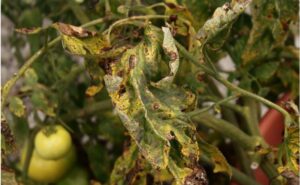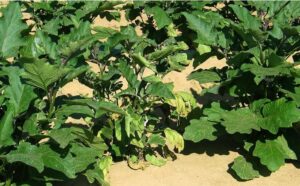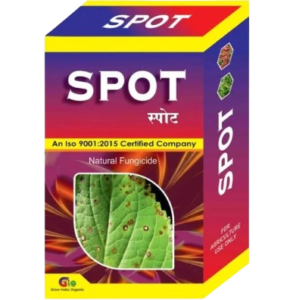Hello everyone, ln this article we will know about verticillium wilt disease and it’s important factor like introduction, identification, cause of verticillium, precautions and it’s treatment.
Introduction
Verticillium wilt is a plant disease caused by soil borne fungi of the genus verticillium. This fungi invade the plant’s vascular system leading to Symptoms like yellowing, wilting and stunted growth. This disease can effect a wide range of crops including vegetable fruit and or a mental plant.
Read more:
- Anthracnose Disease: Identification, Cause, Precaution And Treatment
- Fusarium Wilt Disease: Identification, Cause, Precaution And Treatment
Identification of verticillium wilt disease

- These involves several step, including observation symptoms, performing diagnostic tests and examining the plant vascular system.
- Leave may start to yellow, particularly older leave, and can show characteristic V- shaped pattern of necrosis.
- Wilting or dropping often on one side of the plant or on invisible branches. Overall growth can be stunted and plants may appear smaller and less vigorous.
- Cutting through the stem may reveal dark brown or black discoloration in vascular tissue. Collect soil or plant tissue samples and isolate microscopic examination.
- Obtain fungal cultures from infected plant tissue. On a selective medium verticillium fungi typically produce a distinctive colony morphology.
- Technique such as PCR can be used to detect specific DNA sequences of verticillium species. Examine sample under a microscope for presence of fungal hyphae and conidia (a sexual spores).
- These fungi produce a characteristic verticillium pattern of the conidia on the conidiophores. Conduct soil as say to check for presence of verticillium microsclerotia.
- This can help determine if the soil is a source of infection. The symptomatic plant tissues for the presence of the pathogen which can confirm infection.
- Ensure that symptoms are not due to other disease such as fusarium wilt or environmental stresses. This often involves comparing symptoms and test results with those specific to the other disease.
Cause of verticillium wilt disease

- Verticillium wilt is caused by fungi of the genus verticillium, primarily verticillium dahliae and verticillium albo-atrum.
- These fungi persist in the soil as resistance structure that can survive for many year without a host.
- The fungi enter plant through the roots and spread through the vascular system.
- High soil moisture level can promote fungal growth and infection the fungi can also infect under a wide range of soil condition.
- The pathogen are adopted to range of temperature but often thrive in moderate temperature 20-25 degree Celsius.
- Different plant species and varieties have varying level of susceptibility to the disease . Some plants are more resistance while others highly Suspectible.
- Plant under a stress from drought and nutrient deficiency are more susceptible to infection.
- These fungi can survive in a variety of soil type but are more problematic in soil with poor drainage or high organic matter.
- The fungi can be spread through contaminated soil and water plant is debris. Infected seed or seedling can introduced the pathogen to new areas.
Read more:
Precaution of verticillium wilt disease
- Select plant varieties that are resistance or tolerant to verticillium wilt.
- Rotate crop with non hot plants to reduce the build up of verticillium fungi in the soil.
- Avoid planting the same crop or related species in the same area for several years.
- Ensure proper soil drainage to avoid condition that favor fungal growth.
- Use disinfectants to clean tools and equipment that come into contact with infection.
- Water plants appropriately to prevent water logging and reduce condition conducive to fungal growth.
Treatment of verticillium wilt disease

- Treating verticillium wilt can be challenging as the disease is caused by soil borne fungi that persist in the soil for long periodic.
- Rotate crops with non host species to reduce pathogen levels in the soil. Avoid planting susceptible crops in the same area for several year.
- While not always high effective certain fungicides may help manage the disease.
- Consult with agriculture expert to identify suitable products and application method.
- Apply beneficial microbes or bio fungicides that can help suppress verticillium fungi.
- Products containing may be used for. In your proper planting technic and spacing to reduce plant stress and improve air circulation.
- Inspect plant regularly for early sign of verticillium to take prompt action if symptoms appear.
Conclusion of verticillium wilt disease
Verticillium wilt is a soil borne fungal disease that affect a wide range of plants including vegetable trees. It caused by fungi in the genus verticillium.
These disease lead to wilting chlorosis and stunted growth in infected plant. The fungus affect the plant vascular system. Improving soil health through organic matter adding and proper Drainage can help reduce the impact of disease.
Removing and destroying infected plant and practicing d good garden hygiene can limit the spread of the fungus. Although less commonly used certain fungicides might offer some control. They are not a cure and should be part of integrated management approach.
1. What is verticillium wilt disease caused by?
These is caused by soil borne fungi of the genus verticillium. These fungi infect plants leading to symptoms like wilting, yellowing of leave and reduce growth.
2. How is verticillium is spread?
These spread primary through soil borne fungal spores .This fungi can be introduced to new areas by contaminated soil plant debris or tools. It can also spread via infected plant root and by water movement in the soil.
3. What is the best fertilization for verticillium wilt disease?
There is not a specific fertilizer that cures what is verticillium wilt but using a balance will rounded fertilizer can help strengthen plant and improve their overall health making them more resilient to disease. Organic matter such as compost support plant recovery.
4. What fungicide is used for verticillium?
Fungicide like chlorothalonil or soil fumigant may help manage verticillium but they are often less effective than cultural practices and resistance plant varieties.
5. How to you treatment verticillium wilt disease?
- Select plant bred to resistance these disease.
- Practice crop rotation and soil to improve it structure and fertility.
- This help prevent the spread of that disease.
- Some can help reduce fungal population but they can often less effective than preventive.
- Preventive through good cultural practice is usually the most effective approach
